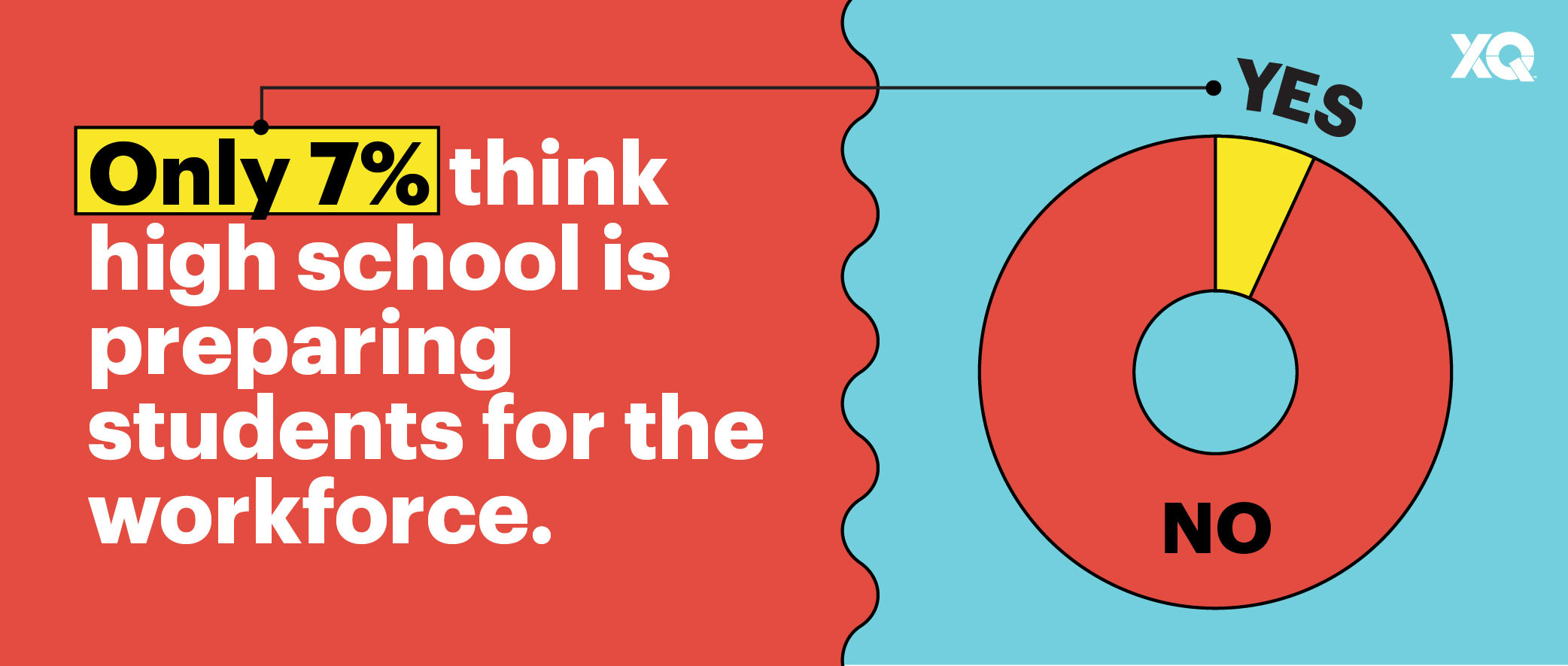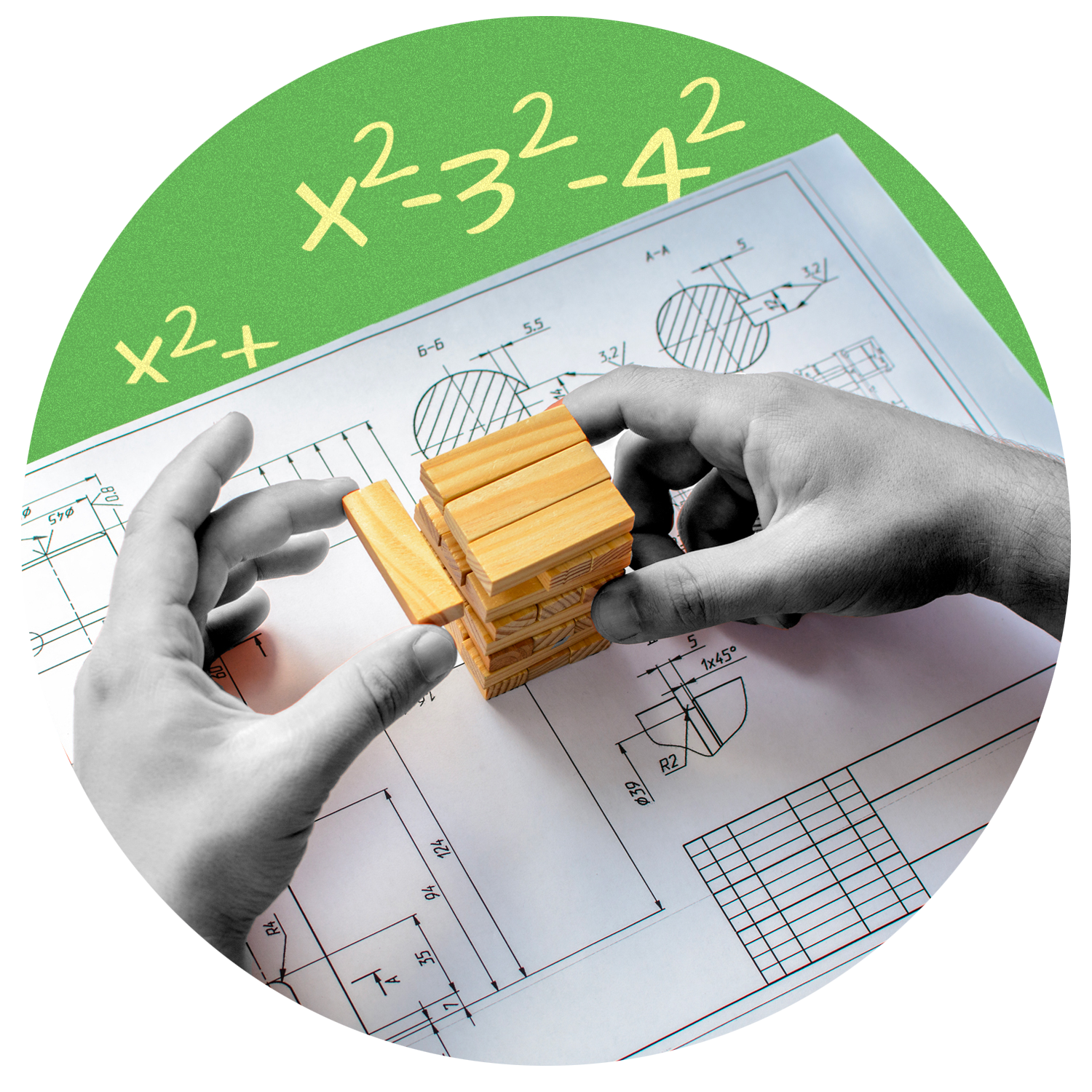Do High Schools Prepare Students for Careers?
We know that today’s learners and high school graduates need to be well-prepared to enter postsecondary education and the workforce. But do they have the skills and knowledge to pursue their passions? What should career-preparedness look like in a rapidly-changing, 21st-century context?
We polled students, teachers, parents, and employers across the nation about whether high school is preparing students for careers. The consensus was clear: of more than 300 participants, most respondents don’t think high school is doing enough to prepare students for future jobs.
These responses affirm current research and trends. As the future of work becomes increasingly automated, skills like critical thinking, creativity, adaptability, and being able to apply knowledge in new contexts, are more important than ever. Yet high schools often fail to teach these skills. In one survey, a large percentage of high school graduates reported feeling unprepared for work, concerned that their high school learning won’t translate to real-world challenges. At the same time, the number of students going directly into the workforce from high school is on the rise, with a third of all high school graduates not going straight to a two- or four-year college, a fact that appears to be on the rise due to the COVID pandemic.
Since the 1990s and accelerating over the past two decades, the majority of well-paid jobs—especially those with career pathways—have required education beyond high school. A common thread in the skills that have been associated with higher education and good jobs was captured in the National Academy of Sciences 2012 report, Education for Life and Work. This report referred to “transferability,” which means being able to apply knowledge and skills in new and unfamiliar situations and to continue to learn new skills. More and more, it’s clear that high schools should be equipping students with these skills to prepare them all for good entry-level jobs, and to pursue postsecondary education for their career paths of choice and economic stability.
With this in mind, we paired results from our poll with research and expert perspectives to ask: What can we do to transform high school and empower students to pursue the careers of their dreams?

Is High School preparing students for working life?
Only seven percent of the total participants in our audience poll said they believe high school is preparing students for the workforce. A whopping 93 percent believe high school needs to do more.

Some Career and Technical Education high schools and programs provide excellent preparation for the workforce, as well as schools in partnership with specific industries. But experts we spoke with say most comprehensive high schools only offer these important experiences to small groups of students.

“The challenge is schools are not designed, nor resourced, nor staffed, to provide things that would help build workplace skills and engineer transfer from other domains—like work-based learning, internships, community service—at a scale where they are normative for all. They are designed to provide this to a few. Success is often defined in improving access from 10 percent of students to 15 percent, which can be reported as a 50 percent increase.”
-Robert Balfanz, research professor at the Center for the Social Organization of Schools at Johns Hopkins University School of Education, and director of the Everyone Graduates Center.
Employers and academics have been concerned about this for decades. Balfanz noted the 1991 report by the U.S. Department of Labor—the Secretary’s Commission on Achieving Necessary Skills—that said high schools need to focus more on thinking skills. It broke these skills down into creative thinking, decision making, problem-solving, seeing things in the mind’s eye, and knowing how to learn.
For students to learn those skills, high schools need to provide both ensure that these competencies are integrated into academic courses and also provide work-based learning, internships, and community service for all students. They can do this with community partnerships, one of the six research-based XQ Design Principles that can lead to student success. By connecting students with outside businesses and organizations, high schools can also help students discover which jobs they are passionate about, and equip them with the skills and hands-on experience they’ll need to be successful.
XQ is helping high schools create these types of experiences. Through a partnership with the nonprofit Atlas Center for Excellence, biology students at Latitude, an XQ school in Oakland, California, got to perform frog dissections led by professionals from Science from Scientists. Another XQ school, Purdue Polytechnic High School (PPHS) in Indianapolis, Indiana is the result of an intentional effort by Purdue University and state and local business leaders to raise the number of students from underrepresented backgrounds attending Purdue and going into STEM careers.
PPHS uses real-world projects aligned to state standards and Indiana’s workforce development goals. Its students all get a chance to work with local businesses and other partners on projects related to real-world challenges. For example, one group of students created a multi-step wellness plan for the school, including measures like daily wellness activities and an overhaul of the cafeteria menu. They worked alongside Purdue professors and students from the College of Pharmacy’s Center for Health Equity and Innovation. This partnership not only deepened the rigor of students’ work; it also exposed students to college and career pathways in healthcare and community advocacy.
As our report High School and the Future of Work illustrates, graduating students who are career-ready benefits employers, local economies, and even the national GDP. Preparing students for the future of work is crucial to economic growth. Students also need good jobs, which Gallup defined as one with 30-plus hours of work a week with a consistent paycheck from an employer.
How Students Think About Career Readiness
When we asked students if they believe high school is doing enough to prepare them for a future career, 67 percent said no. That’s high, but adults seemed even more pessimistic. Among teachers, parents, and other non-students, 93 percent said high school isn’t doing enough to prepare students for careers.
This dim view of whether high school prepares students for careers could point to a lack of relevance in student learning. Another one of our XQ Design Principles is meaningful, engaged learning—learning that is challenging, aligned to students’ passions, and highly relevant to real life. These learning experiences give students access to the kind of work they’ll encounter in their careers beyond high school.


“If we don’t create these opportunities for young people to explore their strengths, interests, and passions and connect them to the world of work, we are not preparing students to successfully navigate the world outside of school.”
-Katie Martin, author of “Learner-Centered Innovation” and “Evolving Education,” and Chief Impact Officer at Learner-Centered Collaborative.

“The fascinating thing is that kids do learn life skills in extracurriculars such as sports, theater, student government, and the like. It is the rest of high school life that is the issue: academics are so entirely cut off from real-world contexts, and from the opportunity to apply and transfer knowledge and skills from one context to another, that graduating seniors simply can’t cope with the complexities that life serves up to them after they leave school.”
-Andy Calkins, Co-Director at Next Generation Learning Challenges, which came up with the MyWays framework for what students should know.
Collaborations between high schools and businesses can make learning more meaningful. A model called P-TECH started more than a decade ago as a partnership between the New York City Department of Education, the City University of New York, and IBM. It now has more than 300 schools working with different companies all over the U.S. and in other countries, too, according to Rashid Davis, principal of the first Pathways in Technology Early College High School in Brooklyn. It’s an early college 9-14 school where students can graduate with a high school diploma plus an industry-certified college-level associate degree in six years, allowing them to get good-paying jobs.
Davis said this is especially important for students who might not otherwise learn about STEM careers. Our XQ Learner Outcomes identified several key competencies schools can focus on to prepare students for college and career paths. One of these outcomes, Original Thinkers for an Uncertain World, relies on skills such as critical thinking, creative thinking, and problem seeking and solving.

“If you’re not living around engineers and computer scientists, you may not think that that’s realistic because of the ZIP code in which you live… So you have to be able to make sure that you can bring industry and college into the more underserved communities because it’s not that the talent isn’t there.”
-Rashid Davis, principal of Pathways in Technology Early College High School in Brooklyn
The P-TECH network in New York City includes nine schools. According to data from ZipRecruiter, students hired by IBM can make more than $100,000 a year.
At P-TECH, Davis said more than 60 percent of his students experience industry and college by 12th grade. He believes high schools shouldn’t distinguish so much between college and career paths because students need similar preparation for both. “It’s college and career-ready. It’s not one or the other,” he explained. “You need the group dynamics. You need the critical thinking skills. You need the problem-solving for both college and careers.”
Internships and work experiences can lead to jobs, even for schools that aren’t located near large companies. Elizabethton High School is an XQ school in a rural northeastern corner of Tennessee that school launched a virtual reality lab and class. But there weren’t any local partners who could work with the students. In 2019, a quick-thinking teacher reached out to a virtual reality company in Jackson, Mississippi after seeing its CEO on TV. The CEO accepted the teacher’s invitation to visit Elizabethton and was impressed enough to offer paid summer internships to students. One student leveraged that into a full-time job after graduation and even saved enough money to put a down payment on a house.
Examples like these show why partnerships with businesses, colleges, and community organizations play a critical role in making high school feel more meaningful and engaging for students—while also setting them up better for success.

Are Students Being Prepared for Jobs That No Longer Exist?
Over the past decade, technological advancements have fueled a massive shift in the nature of work. Jobs that used to be performed by workers are now increasingly automated, and many of today’s students will graduate to pursue jobs that don’t yet exist. Recently, artificial intelligence programs such as ChatGPT have even made their way into the classroom, forcing educators to rethink how they teach certain skills to students.
The pandemic accelerated these trends. A 2021 McKinsey report linked the pandemic to an increase in automation and A.I. It found up to 25 percent more workers than previously estimated may need to switch occupations. These career changes will require additional learning and skills.
Success in this ever-changing career landscape requires a different set of skills than those relied upon by previous generations. But overall, high schools have failed to catch up. A ManpowerGroup report on the talent shortage in hiring suggests that the most in-demand skills for the next generation of workers include adaptability, creativity, problem-solving, and collaboration—exactly the kind of interdisciplinary, real-world skills missing from traditional classrooms. We have identified all of these skills in our XQ Learner Outcomes, and have also developed a competency rubric so educators can better assess student outcomes.
Tom Vander Ark, CEO and partner at Getting Smart, said typical comprehensive high schools aren’t teaching leadership or real-world skills. He said that’s because they’re wedded to an old design structure, an “infantilization of kids with bell schedules and rows and small tasks that are devoid of a sense of purpose or context.” Meanwhile, he said 21st century professions ranging from healthcare to real estate and information technology demand a different approach.

“Almost all work now in every sector is done on diverse teams using smart tools and attacking new problems. Instead of doing individual work, it’s collaborative work. Instead of doing small problems, it’s big problems. Instead of right answers, it’s a matter of best answers.”
-Tom Vander Ark, CEO and Partner at Getting Smart
He cited Dr. Atul Gawande, author of “Being Mortal,” who told Frontline, “It’s not just about how smart you are anymore as a doctor, it’s about how you have to be able to work with teams and how mistakes get made and how you handle them, and how you learn.”
At XQ, our research-based Learner Outcomes include generous collaborators for tough problems. We describe these learners as self-aware team members who show up with enthusiasm and humility to work alongside others. By providing opportunities for collaborative learning, educators can prepare students to work with others to take on the complex challenges of the future.
What can high schools do to better prepare students for the working world?
We asked students, teachers, employers, and parents what the number one thing is that high schools could do better to prepare students for the working world. The most cited response was real-life skills. These include time management, public speaking, digital tools (for programs such as Excel and Google Analytics), and pre-professional training opportunities like resume workshops.

Memorizing facts and formulas isn’t as important as understanding them—because access to knowledge has never been easier. What we do need is for students to become Master of Fundamental Literacies, another XQ Learner Outcome. Students who master these literacy outcomes are able to think across the disciplines and integrate skills such as thinking mathematically, reasoning scientifically, and communicating and receiving ideas.

“Today, we can find the answer to any question that we have with a couple of strokes of the keyboard or swipes on a smartphone. What is the volume of an Ellipsoid? V =4/3πr1r2r3. Who was the 19th President? Rutherford B. Hayes. How do you calculate mass with kinetic energy? m = hv^2. How do I know these things? I don’t. I Googled it.”
That’s why Osborn, of RIDE, said young people need to be able to “develop the skills to seek out quality information, think critically, and to solve the problems in front of them.” He added that teachers recognize more than anyone what’s working for kids “and how to bring problem-solving and critical thinking to life in our classrooms.”
In partnership with XQ, Rhode Island conducted a statewide opportunity audit in 2020 to examine whether high schools were preparing all students equally well for success. Using the Educational Opportunity Audit (EOA) developed by XQ, RIDE was able to get an in-depth portrait of students’ outcomes to better identify and address equity gaps. Osborn said about half the state’s high school students worried they had little opportunity to pursue their passions during high school. And he said, “only one out of four students said they believe their classes always give them useful information for what they plan to do in life.”
The state is now putting more emphasis on “Work-Based Learning,” which includes apprenticeships, internships, service learning, school-based enterprise, and industry projects. Rhode Island’s new Readiness-Based Graduation Requirements require each high school to adopt a policy which recognizes work-based learning for academic credit. The state is also talking with stakeholders about how to develop a blueprint for differently-abled students.
Vander Ark, of Getting Smart, said a growing recognition of what high school graduates really need to succeed is fueling community partnerships all over the country. In Kansas City, the Real World Learning initiative includes Market Value Assets, a collection of experiences for students including internships, entrepreneurial experiences, and college credits. Davis, of P-TECH, noted that employability skills also include academic content. “Low-skill jobs are not looking at those critical thinking skills that you’re talking about,” he explained. “So you’re really talking about a nuanced reality of skills that industry says are valuable when it comes to work.”
Real-world, collaborative projects are at the heart of XQ high schools, including Latitude in Oakland, California. Latitude students have worked alongside tech giants, smaller startups, civil rights attorneys, and art gallery owners. They’ve also embarked on science, technology, engineering, arts, and math (STEAM) projects that address the issues facing their city—from homelessness on the streets, to monitoring the water quality of San Francisco Bay. In the 2021-22 academic year, nearly half of Latitude’s students had internships. One completed the Global Surgery summer program with UCSF’s Department of Surgery, and another conducted a creative marketing internship with the San Francisco Symphony.
In New York City, the Brooklyn STEAM Center is modernizing the old-fashioned notion of vocational education by connecting it to high-skill, high demand, vibrant careers. Diverse classes of students from eight Brooklyn high schools take classes in six different pathways: computer science and information; cybersecurity; construction technology, which includes making solar panels; design and engineering, with architectural drafting and 3D design; film and media; and culinary arts. Students say these pathways help them develop their passions while giving them opportunities to speak to professionals on a daily basis.
The STEAM Center is located in the Brooklyn Navy Yard, an industrial campus with hundreds of businesses. Employers and students work together to meet the demands of the future. Students graduate with college credits, particularly in career-related areas through partnerships with the City University of New York (CUNY) colleges and a local private college, and with industry-recogned certifications in their career path. Brooklyn STEAM is a new model that upends the division between college readiness and career readiness by integrating the two—a full preparation for students to thrive in the future. Brooklyn STEAM is part of XQ’s collaboration with the New York City Department of Education to create and support innovative high school models.
Rachelle Dené Poth, a STEAM educator and consultant based in Pennsylvania, described how high schools can support students in exploring careers with six school-based programs:
- Work-based learning programs
- Internship programs
- Cooperative Education programs
- Career and Technical Education (CTE) programs
- Job Shadowing
- Apprenticeships
“Students aren’t just working and then signing off that they did the work,” Poth wrote. “They are working, meeting certain criteria, and reporting back on what they learned in their job at their apprenticeship or from their internship.”
High school isn’t the only place that needs to do better at preparing students for jobs. Davis noted that many college majors also aren’t aligned with what careers demand, adding the “three-legged stool of high school, college, and industry need to always be on the same page.”
This desire for relevant, life-skills education reflects the reality of work today. To succeed in a rapidly changing job market, students’ abilities to work with others, manage themselves, and thrive under a variety of circumstances are just as important as their academic abilities.
Takeaways
The responses we heard echo what many people in education say: high school is not doing enough to prepare students for careers. The vast majority of adults believe that high school does not prepare students to enter the workforce, and students themselves report feeling underprepared to pursue their careers after graduating.
The consequences are significant: students lose valuable opportunities for future mobility and agency, and our communities suffer when high school graduates aren’t ready to take on the important work of the future.
Despite this trend, success stories from high schools across the country show that, with creativity and bold thinking, school leaders and teachers can transform these outcomes. To better prepare students for careers, schools can:
- Invest in relevant curricula, like project-based and interdisciplinary learning
- Work with community partners to give students access to real-world work environments
- Explore competency-based learning, defining competencies to include life skills alongside academic knowledge
For more on how high school should prepare students for the future, explore other posts in our series.
Why the School System Needs to Change, and How
How Schools Use SEL to Prepare Students for an Uncertain Future
XQ Super Schools are STEAMing Ahead to the Future of Work
3 Tips for Teachers to Foster Student Internships in Highschool
How Important is Education for Economic Growth?
How to Find Internships in High School (Advice From a College Intern)
From the Classroom to the ‘Real World’

Sign up for our newsletter
Get the latest educator insights and practical classroom tips every other week, direct from the XQ community
Follow us to #RethinkHighSchool